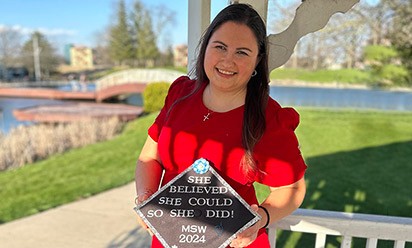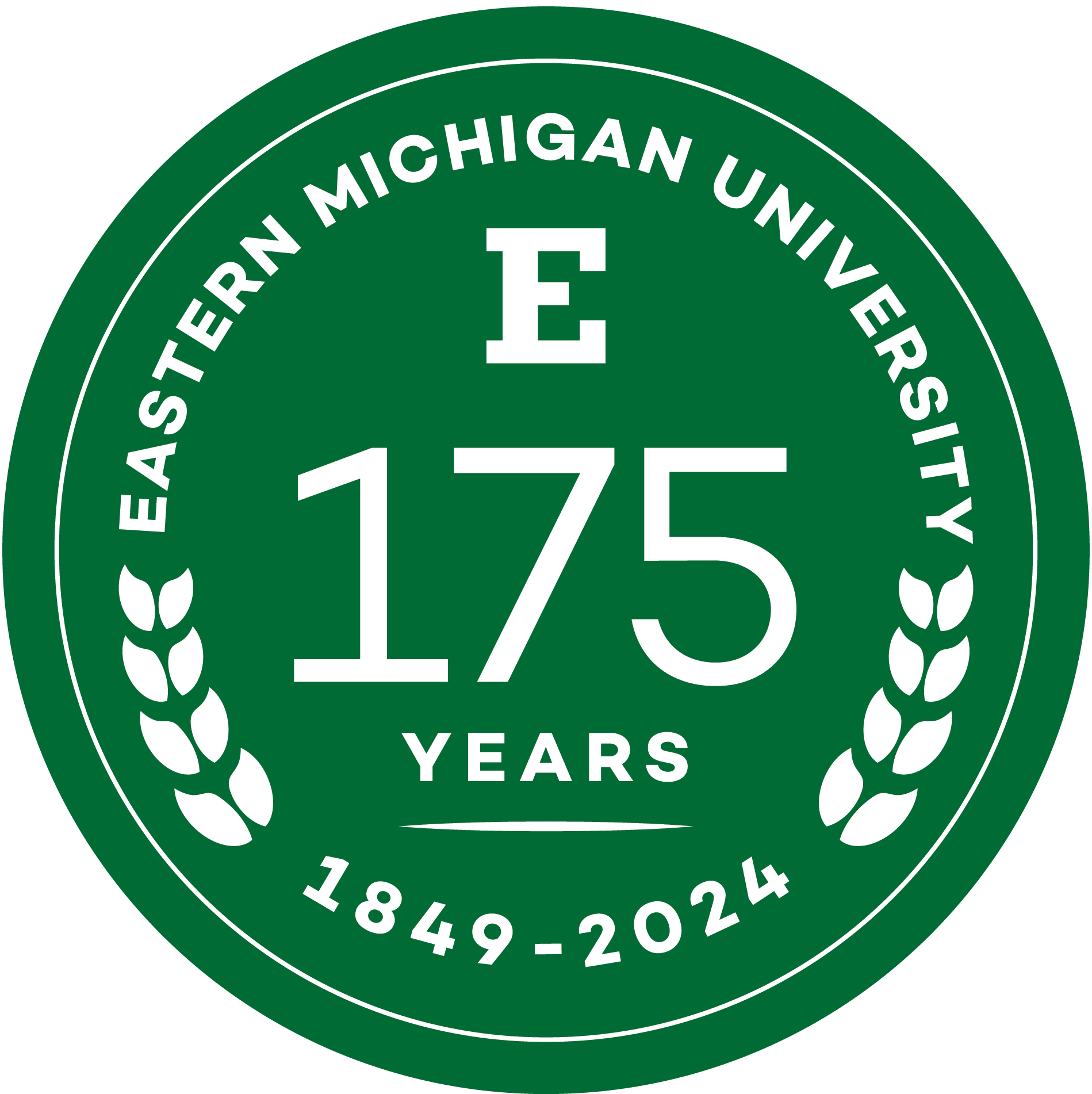The 2021 Graduate Research Conference (GRC) will feature projects across disciplines, departments, and colleges in a virtual format on March 19
Topics include use of word ‘look,’ effects of Flint water on birds, and support of Black female athletic training students

YPSILANTI – The annual Graduate Research Conference (GRC) will be held on Friday, March 19 on a virtual platform. The GRC will exhibit more than 100 scholarly and creative research projects of Eastern Michigan University’s graduate students across a range of disciplines, departments, and colleges.
This year’s event will offer live oral presentation sessions every hour, starting at 9 a.m. until 4:15 p.m. and a live poster session from 10:30 - 11:45 a.m. There will also be recorded oral and poster presentations available to view throughout the entire day.
As in years past, there will also be a live keynote speaker session from noon to 1 p.m. . Dr. Shawn T. Mason, a GRC alumnus and current Director of Research & Outcomes for Johnson & Johnson Health and Wellness Solutions; is this year’s keynote speaker. The keynote session will also include presentations from the two winners of the Virtual 3-Minute-Thesis Competition, EMU students L’Meese Greaney and Dorothy Zahor.
For further updates, see the GRC website.
A sample of students, their academic programs, and projects are as follows:
On the Syntactic and Pragmatic Interpretation of the Imperative Discourse Marker ‘Look, here’s the deal.’
L’Meese Greaney
Eric Acton and Daniel Seely, faculty mentors
The English imperative discourse marker (IDM) “look” has undergone limited study. Imperatives and discourse markers have been extensively examined independently, and together from syntactic and pragmatic perspectives. However, the IDM “look” is not well understood, particularly in regard to its syntactic and pragmatic roles, its illocutionary force, and whether or not that particular word threatens the hearer’s sense of autonomy, and its relation to manipulation theory.
This research explores when, where, how, and by whom IDM “look” is used in presidential and vice-presidential debates from 2008-2020, from both syntactic and pragmatic perspectives. For instance, preliminary results show that men and Democrats use the IDM “look” at significantly higher rates than women and Republicans, respectively, suggesting that, perhaps, IDM “look” is used to signal power and a desire to control the discourse. The research explores complexities that political affiliation and gender, history and grammaticalization, syntax, and pragmatics inject into the determination of the aforementioned with the goal of understanding its impact on politeness theory and manipulation theory in and outside of the political sphere.
Did the Flint Water Crisis Pollute Urban Soils? A Look at Urban Bird Blood Lead
Dorothy Zahor
Jamie Cornelius, Brian Connolly, Peter Bednekoff, faculty mentors
Lead (Pb) is a widespread pollutant found in human-dominated landscapes. In urban areas, residual lead persists in soils for decades. The American robin (Turdus migratorius) breeds in urban areas across North America and specializes on earthworms, resulting in soil consumption during foraging.
During the Flint drinking water crisis, lawn watering may have introduced lead into urban soils. Robins were captured at watered and unwatered sites within Flint, and their blood lead levels and body condition were compared to robins captured at a reference urban site and rural sites. Blood lead was highest in robins captured in watered sites of Flint. Lower body condition was correlated with higher blood lead levels only in the watered sites of Flint, suggesting these birds are experiencing negative health impacts. Blood lead in robins seems to reflect elevated soil lead levels and may serve as a feasible soil lead bioindicator in communities vulnerable to pollution.
Graduate Leadership in a Virtual World: Executing Innovative Artistic Events During a Global Pandemic in a Classroom Setting
Sydney Anderson Dodge and Brittany Nicol
Susan Booth, faculty mentor
The COVID-19 shutdowns have widely impacted the arts and culture sector, forcing many artists out of their jobs and many organizations to close their doors. In response, the AMA 300/552 Arts Management class wanted to provide an opportunity to spotlight the impact that EMU artists have made before and during the pandemic. Professor Susan Booth gave graduate students the responsibility of leading undergraduate students in creating a virtual event of their choosing.
Through surveys and group discussion, the class created an entirely virtual documentary centered around EMU student artists titled “EMU: Return to the Canvas.” The documentary interviews student artists from various backgrounds and mediums. This project thrived during unprecedented circumstances, leading to an innovative product that will preserve this important moment in history for EMU artists.
Race, Womanhood, and Adaptation to Settler Colonialism in the Diaries of Mary Hobart Williams
Rachel Schnurr
John McCurdy, faculty mentor
In 1815, when the United States moved to control and occupy what was then the “Northwest Territory,” thousands of native peoples held sovereignty in the region that now includes Michigan, Indiana, and Wisconsin. Residents were primarily the mixed-race or “métis” offspring of French fur traders and their Algonquin wives. This thesis project seeks to answer the question: How did the mixed race, bicultural inhabitants of the western Great Lakes respond and adapt to the pressures of Americanization in the nineteenth century?
My presentation will focus on the creole community of “La Baye des Puants,” now Green Bay, Wisconsin, as it navigated settler colonialism. In particular, I will focus on the experience of one individual, a Franco-Menominee woman named Mary Hobart Williams, who left behind two personal diaries. Williams’ diaries demonstrate that individuals manipulated their own racial and gender identities, in order to survive in the changing landscape. This does not mean that they disappeared, but rather that they ceased to be “Indian” in the eyes of future generations.
Black Female Athletic Training Students and the Effects of Racism in Athletic Training Programs
Naiomi Wilson
Aaron Struminger and Courtney Lewis, faculty mentors
Over the past decade there has been an increase in the number of Black student athletes (SAs) at the collegiate level. However, there is a lack of representation in the athletic training staff responsible for caring for this diverse population. As the United States becomes a more diverse country, the field of athletic training has not. There is a growing need for Black female athletic trainers in all settings of athletic training.
It is hypothesized that there is a negative impact on Black females in athletic training programs due to racism that they face throughout their didactic and clinical experiences.
This project investigated participants’ personal experiences with racism and sexism during their time in the athletic training programs. It is expected that the results will help the athletic training profession to better understand how Black female athletic training students can be supported during their educational experiences.
A Framework to Assess the Rehabilitation of Historic Cave Dwelling in Libya Using Modernization Theory and Technology Acceptance Model
Ebrahim, Salaheddin
Shinming Shyu, faculty mentor
This dissertation examines the associations between the technology acceptance model and modernization theory with Libyans’ perceptions of cave-dwellings in the Nafusa Mountains region, west of the capital city of Tripoli. It formally tests the hypotheses linking cave dwellings’ ease of use, usefulness, educational level, income-perceived category, age, gender, and employment type with Libyans’ perceived intentions to live in a modernized cave dwelling.
This study offers a framework demonstrating how renewable energy systems can make Libyan cave dwellings sustainable for local citizens. Using 450 responses from Libyans worldwide, this study found that the technology acceptance model is a statistically significant framework for understanding Libyans’ intentions to live in modernized cave dwellings. More specifically, Libyans were more willing to live in such homes if they perceived them as easy to construct, maintain and utilize; useful for decreasing their utility bills; and providing comfortable living standards. More educated and high-income-perception individuals are associated with a higher likelihood of living in a cave dwelling.
About Eastern Michigan University
Founded in 1849, Eastern is the second oldest public university in Michigan. It currently serves nearly 16,000 students pursuing undergraduate, graduate, specialist, doctoral and certificate degrees in the arts, sciences and professions. In all, more than 300 majors, minors and concentrations are delivered through the University's Colleges of Arts and Sciences; Business; Education; Engineering and Technology; Health and Human Services; and, its graduate school. EMU is regularly recognized by national publications for its excellence, diversity, and commitment to applied education. For more information about Eastern Michigan University, visit the University's website.
More Stories
Eastern Michigan University Vice President for Enrollment Management Katie Condon-Martin to help shed light on FAFSA “fiasco” as part of Bridge Michigan Zoom discussion on April 24.

Eastern Michigan University awards Summer Research and Creative Activity Grants.

Eastern Michigan University to launch new Bachelor of Business Administration in Financial Planning and Wealth Management degree.

Eastern Michigan University empowers student-faculty collaboration with Undergraduate Symposium Research Fellow Awards.

Eastern Michigan University senior Raya Lasiewski inspires hope and healing through personal journey with eating disorder.

